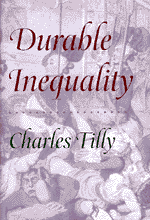

![]()
![]()

Tilly's aim is to argue against the idea that inequality can be understood gradationally, for instance as economists frequently see it in terms of income curves in which no abrupt social differences can be discerned. He emphasises instead the categorical nature of social inequality. People draw boundaries between themselves and 'others', and so form 'categorical pairs'. The institutionalisation and sedimentation of these paired categories for Tilly generates 'durable inequality'. Most of Tilly's book shows how these durable inequalities can be seen as arising from four processes. The first of these, exploitation, linked to the extraction of a surplus, is borrowed almost directly from Marx. The second, 'opportunity hoarding', where insiders seek to preserve their advantages for their own use, can also be seen as drawing on Weber's notion of social closure. It is perhaps the last two processes, emulation and adaptation, which are more original and arresting. Tilly's claim is that the diffusion and institutionalisation of social inequality takes place as modes of exploitation and opportunity hoarding are extended, copied, and adapted. By drawing attention to these processes he emphasises that durable inequality is not to be seen as a macro-structural phenomenon, but rather as one located in smaller scale institutional forms which are then extended into other settings. This allows Tilly to present an account more sensitive to the interplay between micro and macro contexts, and to the fluidity of historical process.
Tilly's book is deductive in tone. He uses an array of historical examples to back up his theoretical arguments, but these serve to illustrate, rather than demonstrate, his approach. Somewhat infuriatingly, he tends to use easy, obvious examples rather than ones which appear harder to slot into his perspective and therefore possibly more telling. Thus, he uses the case of South African apartheid to explore the dynamics of exploitation between whites and blacks. Although some of his illustrative material is interesting (I found his discussion of gender segregation in the US particularly stimulating), it can also be frustrating as Tilly skips too quickly to offer comprehensive analyses of any particular topic. He tends not to engage with other sociological approaches to looking at inequality with the result that it is not always clear what advantages he offers over more conventional perspectives. There are no extended conversations with class analysis, or with the human capital approaches of labour economists, for instance.
This having been said there is no doubt that Tilly's ideas about the 'categorical' dynamics of inequality offers the possibility of development and alliance with a number of important current developments in sociology. There are points of contact here for those interested in network theory, critical realism, categorical data analysis, and cultural analysis (for instance drawing on Bourdieu or even post-structuralist currents). I look forward to seeing what an extended application of these ideas might lead to.
Mike Savage
Manchester University